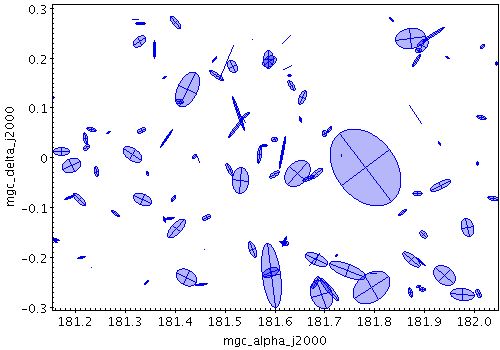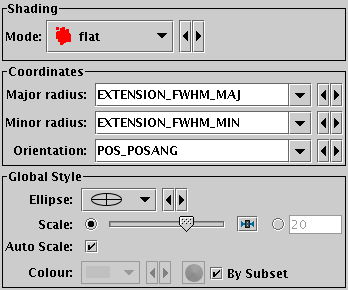Next Previous Up Contents
Next: SkyEllipse Form
Up: Plot Forms
Previous: Error Bars Form
The Ellipse form ( )
draws an ellipse (or rectangle, triangle, or other similar figure) defined by
major and minor radii and an optional rotation angle.
)
draws an ellipse (or rectangle, triangle, or other similar figure) defined by
major and minor radii and an optional rotation angle.

Example XYEllipse plot

Ellipse form configuration panel
The configuration options are:
-
Shading Mode
- See Appendix A.4.6.
-
Primary Radius, Secondary Radius
- The two principal radii for the ellipse, in the same units as the
position coordinates.
It doesn't matter whether the primary is larger than the secondary.
If the Secondary Radius field is left blank, it is assumed to equal
the Primary Radius field, i.e. the ellipses are circles.
-
Orientation
- Position angle in degrees.
This is the angle anticlockwise from the X axis
to the primary radius.
If the value is missing (either this field not filled in or blank in
the data) it is considered to be zero.
-
Ellipse
- Ellipse graphical representation, selected from a range of options
(includes also rectangles, crosses etc).
-
Scale
- Changes the factor by which all ellipse sizes are scaled.
If the ellipses are too small, slide it right, if they are too big,
slide it left. The slider scale is logarithmic.
Alternatively, enter a fixed value in the text field.
-
Auto Scale
- If selected, this option will determine the default ellipse scale size
from the data - it will fix it so that the largest ellipses are a few
tens of pixels long by default.
That scaling can then be adjusted using the Scale slider.
If unselected, then the default position of the Scale slider corresponds
to the actual positions given by the submitted ellipse radii coordinates.
Next Previous Up Contents
Next: SkyEllipse Form
Up: Plot Forms
Previous: Error Bars Form
TOPCAT - Tool for OPerations on Catalogues And Tables
Starlink User Note253
TOPCAT web page:
http://www.starlink.ac.uk/topcat/
Author email:
m.b.taylor@bristol.ac.uk
Mailing list:
topcat-user@jiscmail.ac.uk
 )
draws an ellipse (or rectangle, triangle, or other similar figure) defined by
major and minor radii and an optional rotation angle.
)
draws an ellipse (or rectangle, triangle, or other similar figure) defined by
major and minor radii and an optional rotation angle.
 )
draws an ellipse (or rectangle, triangle, or other similar figure) defined by
major and minor radii and an optional rotation angle.
)
draws an ellipse (or rectangle, triangle, or other similar figure) defined by
major and minor radii and an optional rotation angle.

